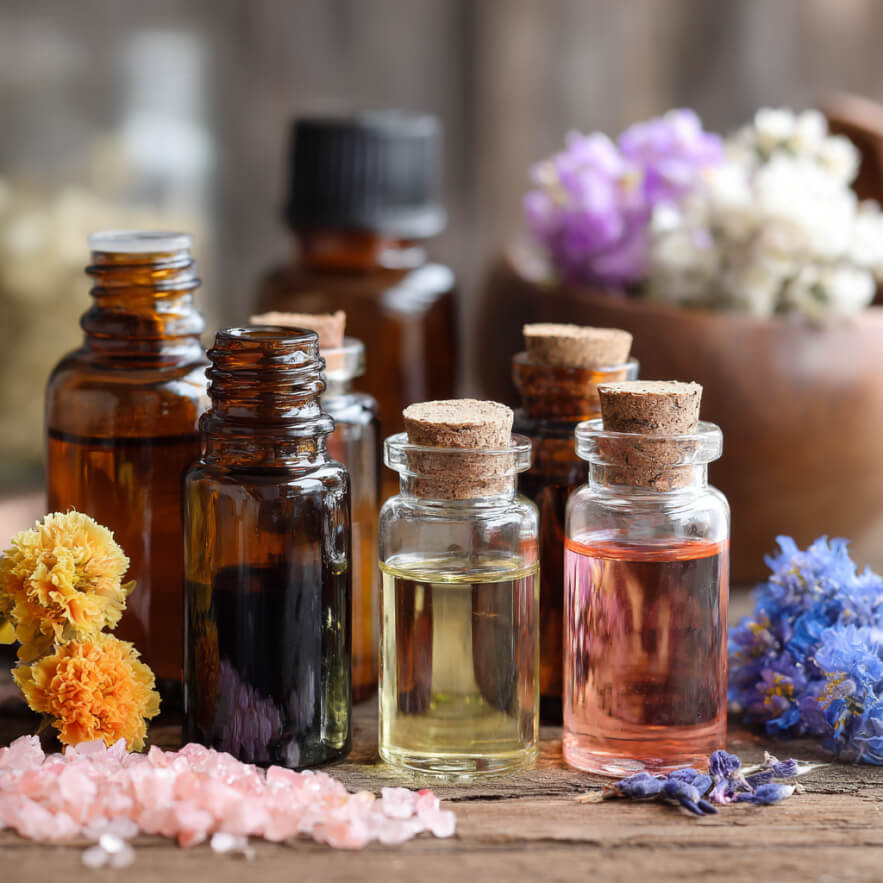Anyone who has ever used essential oils has probably thought about creating their own blends. It’s not as complicated as it seems: the key is to understand the basics, listen to your senses, consider safety, and be open to experimentation. A well-balanced blend can do more than smell nice — it can genuinely help with stress relief, mental clarity, and even immune support.
The basics of blending: where beginners should start
Creating aromatherapy blends requires understanding scent structure and the action of ingredients. Each essential oil blend typically includes top, middle, and base notes. Top notes (like citrus or mint) are light and volatile — they provide the first impression but fade quickly. Middle notes (like lavender or geranium) form the “heart” of the blend, defining its overall character. Base notes (like sandalwood, patchouli, or cedarwood) are long-lasting and ground the scent.
A balanced formula often follows a 3:5:2 ratio — 30% top notes, 50% middle notes, and 20% base notes. While not a strict rule, it’s a helpful guideline for beginners.
It’s also important to understand the therapeutic effects of oils. Not all pleasant-smelling oils are safe. Cinnamon oil, for example, can burn the skin, and excessive rosemary oil may cause headaches. It’s best to begin with gentle, versatile oils like lavender, orange, or tea tree.
Always dilute essential oils in a carrier oil such as almond, jojoba, or coconut oil. Applying undiluted oils directly to the skin is unsafe. A 1–2% dilution is standard for body use and 0.5–1% for facial use. That means using about 2 to 4 drops of essential oil per 10 ml of carrier oil.
Uncommon combinations that really work
Intuitive blends often outperform formal recipes. Many users share successful mixes they discovered spontaneously. One example is black pepper and bergamot — surprisingly effective for morning focus. Black pepper sharpens the mind while bergamot soothes tension. Don’t be afraid to try new pairings, but test with a single drop and observe your reaction.
Another unusual yet effective trio is cedarwood, lavender, and lime. This combination offers calmness and clarity: cedarwood grounds, lavender relaxes, and lime adds a gentle boost of energy. It’s perfect for unwinding after a stressful day.
Here’s a pro tip: try using vanilla CO₂ extract. Unlike synthetic fragrance oils, natural vanilla softens harsh scents and adds a rich, comforting depth. It’s not ideal for workplace blends but works beautifully for cozy evening mixes.
Some advanced blenders use caper seed oil as a base. It’s nearly scent-free and doesn’t interfere with essential oil profiles. Plus, it’s rich in antioxidants and well-suited for mature skin. This detail rarely appears in mainstream guides but can make your blend feel expertly crafted.
Mood blends: recipes for different states
You can easily shift your mood with the right aroma blend. Scents can stir emotion, ease irritability, encourage connection, or enhance focus. Below are some tried-and-true formulas:
- For energy: 2 drops peppermint, 3 drops lemon, 1 drop rosemary. Works great in the morning, especially in colder seasons.
- For relaxation: 3 drops lavender, 2 drops sweet orange, 1 drop ylang-ylang. Ideal in a diffuser during evening wind-down.
- For anxiety: 2 drops frankincense, 2 drops geranium, 1 drop sandalwood. Use in a diffuser or apply to wrists.
- For focus: 2 drops basil, 2 drops grapefruit, 1 drop black pepper. Boosts concentration without overstimulation.
You can adjust the formulas to suit your preferences — swap oils with similar effects or tweak ratios. Pay attention to how your body and mood respond. Sometimes removing just one drop makes the blend feel just right.
Curious why scents have such a deep impact on us?
Check out “The science of scent: how aromatherapy affects mood and memory” for research-based insights and practical examples.
Roll-ons, sprays, and body oils: using blends the right way
Making a blend is only half the journey — using it correctly is just as important. The most popular application methods are aroma roll-ons, sprays for textiles, and diluted oils for skincare. Each method has its own benefits.
An aroma roll-on is a small bottle with a rollerball applicator filled with essential oils diluted in a carrier. Apply to wrists, neck, or behind the ears. Effects typically last 3–4 hours. Base-heavy oils like patchouli, cedarwood, or ylang-ylang work well here.
Sprays can be made using alcohol or floral water as a base. They’re ideal for refreshing bed linens, clothing, or room air. Floral and citrus oils perform particularly well. Always shake before use.
Massage or body oils can be used post-shower on damp skin to help the scent linger. Choose carrier oils carefully: jojoba and macadamia work for facial skin; apricot, almond, or grapeseed oils are better for the body.
Avoid making large batches. Essential oils oxidize over time, and the scent may change. A 7–10 day supply is best. Store your blend in dark glass bottles, away from heat and light.
Common mistakes to avoid: from dilution to storage
Even experienced users make mistakes, especially when blending on the fly. Common errors include overly strong concentration, incompatible oils, or inappropriate carriers. For instance, combining mint and cinnamon may create an unpleasantly sharp scent.
A typical oversight is using blends immediately. Freshly mixed compositions may smell unbalanced. Let them rest at least 24 hours — ideally 72 — to allow the molecules to meld. The aroma will soften and harmonize.
Store your blends in dark glass bottles no larger than 30 ml. Use dropper tops or rollers for easy application. Avoid plastic containers — essential oils degrade plastic and contaminate the blend. Keep storage temperatures under 25°C, away from sunlight and radiators.
If you’re making a facial blend, always perform a patch test on the inner forearm. Reactions can be delayed. Even familiar oils might cause irritation if your skin is sensitive or recently exfoliated.
Questions and answers
Lavender — it’s safe, versatile, and blends well with many oils. It works for relaxation and skincare
Yes, especially with oils like lavender, sandalwood, or neroli. Just make sure the scent isn’t too strong to disturb your sleep.
In a dark glass container, in a cool place away from light and heat. A closed drawer or cabinet is ideal.

